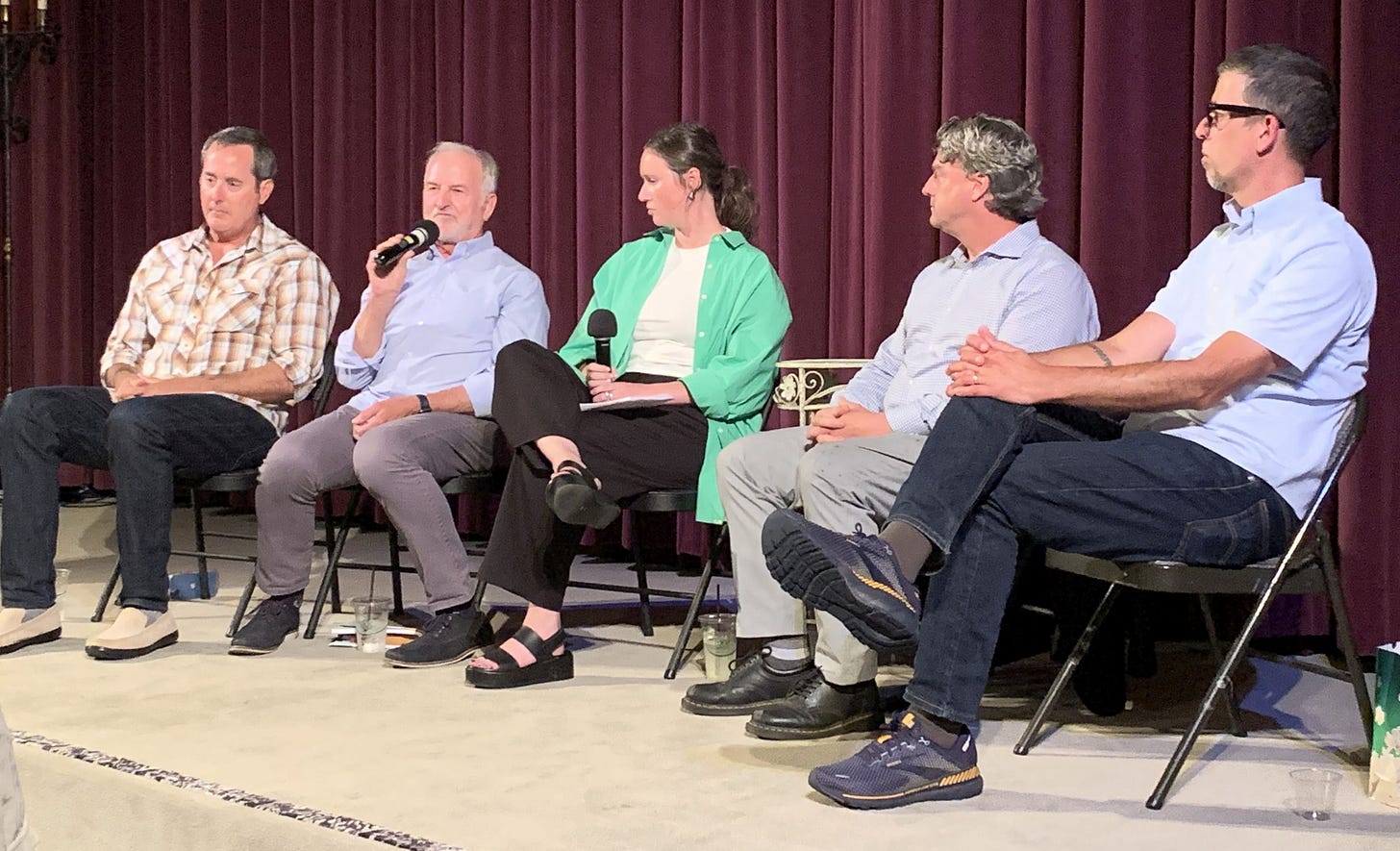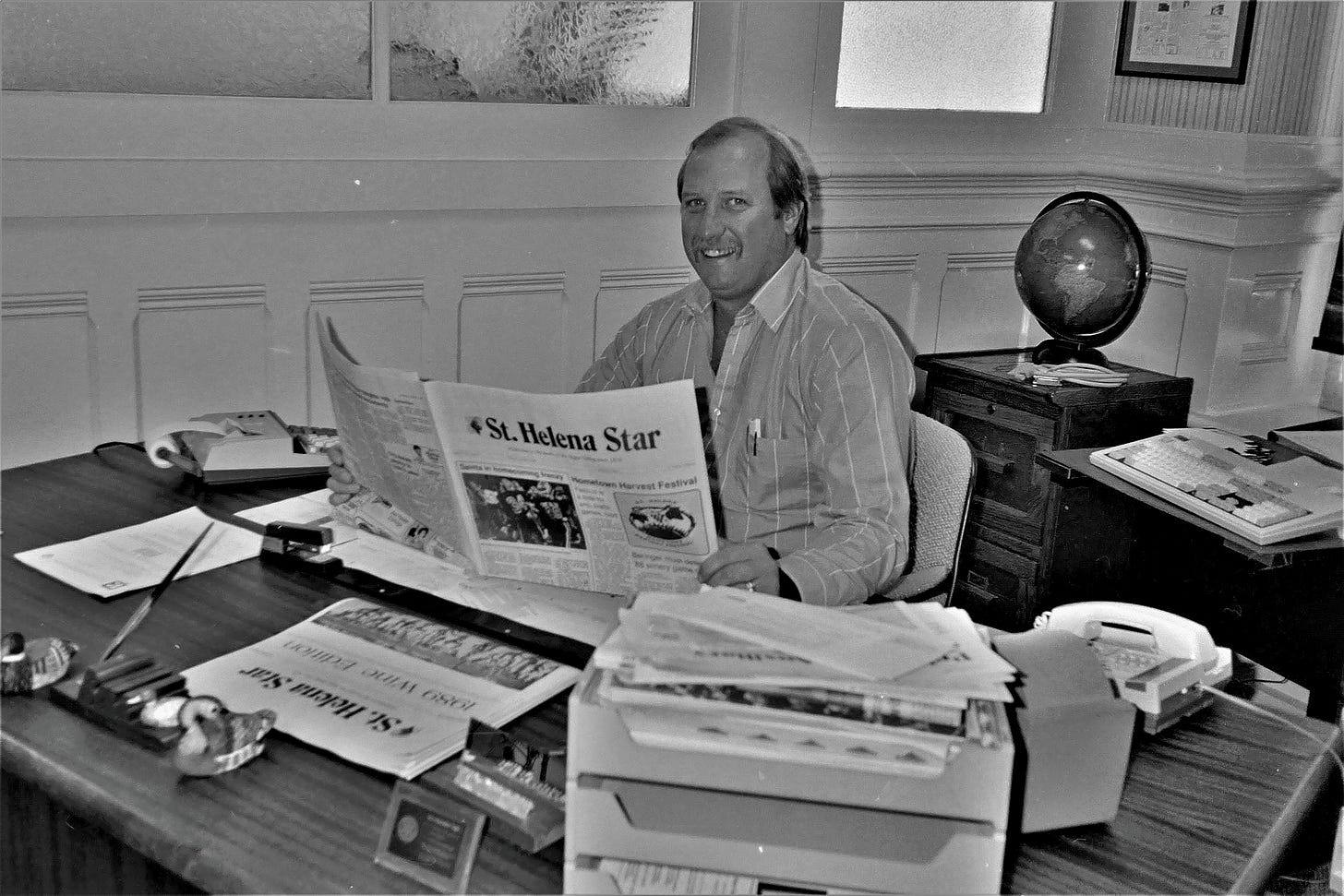ST. HELENA, Calif. — A Bay Area newspaper and media consultant said he doesn’t think there’s any future for newspaper chains, including Lee Enterprises that owns both the Napa Valley Register and the St. Helena Star, because the economics for newspapers today don’t sustain local journalism.

“We have lost over half of local news sources across the country in the last 10 to 15 years, and the other half is at risk of going away in the next few years,” said Joaquin Alvarado, co-founder of Oakland’s Studio To Be, a creative media and consulting agency. To that equation add artificial intelligence that can quickly produce content pieces where most readers can’t tell the difference and the threat to local journalism is even more dire. “What we know as local journalism is no longer possible in the United States, in my opinion,” Alvarado said. “Even in communities that are well-resourced, it’s a Gordian knot.”
Alvarado was part of a panel discussion on a recent Monday night at the Cameo Cinema that focused on the future of local news in St. Helena. Joining him onstage were Terence Mulligan, president and CEO of the Napa Valley Community Foundation; Marc Hand, chair/CEO of Highway 29 Media Company; and Dan Evans, executive editor of the Napa Valley Register. The moderator was Dana Cronin, a freelance multimedia journalist who was born and raised in St. Helena.
Most of those in the audience appeared to be supporters of their beloved St. Helena Star. They wondered: What is the future of the weekly newspaper?
Alvarado answered a question from Cronin: Regarding the sale of the Star, what are the options going forward?
“Have an open conversation with Lee, ask them what their plans are. You have the right to ask.” The second part of the answer is “a little bit like splitting the check at dinner,” he said. “Anybody with resources can solve this problem right now. I don’t think this is anything more than a $3 million problem in the Napa Valley.”
The Napa Valley Community Foundation doesn’t have that kind of money, he added, but it is not impossible to solve this.
The third part of the answer is just to start, get things going. Hand is looking to hire a bilingual/bicultural reporter, supported by a three-year, $225,000 NVCF grant. Alvarado said it might take six months to find the right person. After that first hire, however, there will be six more hires in five or six years because those reporters will tell others -- “If you want to do ‘kick-ass’ journalism, go to the Napa Valley.” He warned, though, that if the consumers aren’t at the table and if the advertisers don’t buy it, “it is really hard to bring this off.”
Last fall the owners of two local newspapers, the Calistoga Tribune and the Yountville Sun, were ready to retire and were seeking a buyer or failing that, were thinking of closing their doors. In response, the newly formed Highway 29 Media Co., a public-benefit corporation, acquired both papers with funds from the Media & Democracy Fund of the Napa Valley Community Foundation. Those funds included $200,000 in donations from local people (collected and bundled up by the NVCF), a $100,000 grant to support public-interest journalism and a $134,000 loan to pay off an SBA loan for the Calistoga Tribune.
Hand said they put together the resources necessary to save those papers, and “the key is doing something here in St. Helena. We have the infrastructure in place to make it sustainable,” including a core of great people and the capital necessary.
The goal is to have “very focused and dedicated newspapers in each of the communities up and down the valley,” he said. “I think that’s doable and what we’re interested in doing.” He remains committed to providing digital news platforms and producing print newspapers, even though prices for printing newspapers are up 40% in the past year.
Estimates are that it might take $1 million to buy the Star and, Hand said, maybe half that to launch something, probably a competing newspaper, in St. Helena. He added, “The Sun and Tribune wouldn’t be here without the foundation. It’s a shining example of what community foundations across the nation should be doing, although most aren’t.”
Both Hand and Mulligan said local news sources, including newspapers, are important to democracy. According to a July 28 NVCF press release, “We have always believed that our community and our democracy are more vibrant when everyone participates in the decisions we make about our future.
“Independent local news fosters civic engagement. When communities lose local news outlets, we also risk losing representation for diverse communities in the valley.
“That’s why we launched the Media & Democracy Fund to preserve independent journalism that will cover the important topics affecting our quality of life — like housing, education and climate — and will inform and engage residents in solutions to such issues.”
The NVCF has hired Alvarado and his firm to study the local media in the Napa Valley. It is expected that his study will be released later this summer.
Local media challenges
Beyond the specific, Alvarado said the challenge to sustaining local media is not just that the business model is flawed but it’s the environment that is difficult, including what Google and Facebook have done to the local advertising market.
“This is not just the perfect storm; this is the perfect storm with a pandemic divided by climate change. Everything that could go wrong is going wrong for local journalism right now,” he said, adding that he has spent the past 15 years trying to find alternative models for local journalism, “trying to build successes that are community-based.”
“The one thing I’ve seen work is community engagement,” he said. “There are all ways to proceed if you have the community by your side. Communities need this (local journalism) if we’re going to be a self-governing democracy.”
Shannon Kuleto, historian, writer and St. Helena resident for 30 years, said for almost half of that time she has had “the extraordinary experience of being a volunteer member serving on the Star’s editorial board, which has given me a front-row seat to the inner workings.” With severe staff cutbacks at both the Star and the Register, “most of us know the news landscape over the last year has become increasingly unsettled.”
In the fall of 2006, the Star’s newsroom included six people, including its editor. Additionally, there were four others in the office handling advertising and subscriptions. Fourteen years later, by the fall of 2020, there was just one person in the office, editor Jesse Duarte. He continues to be the sole employee in St. Helena, doing 90 percent of the work to produce the weekly newspaper, although Evans said newsroom staff at the Napa Valley Register help him out.

“For nearly 150 years, the Star has been our shared voice,” Kuleto said. “What a beautiful thing that we’ve been able to take it for granted, and that we would always have it.” Although the grassroots support for local journalism and the Star is strong in St. Helena, as evidenced by a packed house at the Cameo Cinema, Kuleto said, “In my opinion, we cannot take the status quo and the future for granted.”
Besides Kuleto, the others serving on the Star’s volunteer editorial board were in the audience. They include Norma Ferriz, Bonnie Long, Peter McCrea, Chuck Meibeyer, Gail Showley and Dave Yewell.
Dave Stoneberg is an editor and journalist who has worked at newspapers, including the St. Helena Star, from 2006 to 2020 in both Napa and Lake counties.




